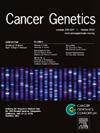60. AI-guided histopathology predicts brain metastasis in lung cancer patients
IF 1.4
4区 医学
Q4 GENETICS & HEREDITY
引用次数: 0
Abstract
Brain metastases can occur in nearly half of patients with early and locally advanced (stage I-III) non-small cell lung cancer (NSCLC). There are no reliable histopathologic or molecular means to identify those who are likely to develop brain metastases. We sought to determine if deep learning (DL) could be applied to routine hematoxylin and eosin (H&E) stained primary tumor tissue sections from Stage I-III NSCLC patients to predict the development of brain metastasis. Diagnostic slides from 158 patients with Stage I to III NSCLC followed for at least 5 years for development of brain metastases (Met+, 65 patients) versus no progression (Met-, 93 patients) were subjected to whole slide imaging. Three separate iterations of DL were performed by first selecting 118 cases (45 Met+, 73 Met-) to train and validate the DL algorithm, while 40 separate cases (20 Met+, 20 Met-) were used as the test set. DL algorithm results were compared to a blinded review by four expert pathologists. The DL-based algorithm was able to distinguish eventual development of brain metastases with an accuracy of 87% (p<0.0001) compared to an average of 57.3% by the four pathologists, and appears to be particularly useful in predicting brain metastases in Stage I patients. DL-based algorithms using routine H&E-stained slides may identify patients likely to develop brain metastases from those that will remain disease free over extended (>5 year) follow-up and may thus be spared systemic therapy.
60.人工智能引导下的组织病理学预测肺癌患者的脑转移
近一半的早期和局部晚期(I-III 期)非小细胞肺癌(NSCLC)患者会发生脑转移。目前还没有可靠的组织病理学或分子方法来识别那些可能发生脑转移的患者。我们试图确定深度学习(DL)能否应用于 I-III 期 NSCLC 患者的常规苏木精和伊红(H&E)染色原发肿瘤组织切片,以预测脑转移的发生。对 158 名随访至少 5 年的 I 至 III 期 NSCLC 患者的诊断切片进行了全切片成像,这些患者均出现脑转移(Met+,65 人)或无进展(Met-,93 人)。首先选择 118 个病例(45 个 Met+,73 个 Met-)来训练和验证 DL 算法,然后分别选择 40 个病例(20 个 Met+,20 个 Met-)作为测试集,对 DL 算法进行了三次迭代。将 DL 算法结果与四位病理专家的盲审结果进行比较。与四位病理学家平均 57.3% 的准确率相比,基于 DL 的算法能够以 87% 的准确率(p<0.0001)区分脑转移的最终发展,而且似乎对预测 I 期患者的脑转移特别有用。使用常规H&E染色切片的基于DL的算法可以从那些在长期(>5年)随访中保持无病的患者中识别出可能发生脑转移的患者,从而避免全身治疗。
本文章由计算机程序翻译,如有差异,请以英文原文为准。
求助全文
约1分钟内获得全文
求助全文
来源期刊

Cancer Genetics
ONCOLOGY-GENETICS & HEREDITY
CiteScore
3.20
自引率
5.30%
发文量
167
审稿时长
27 days
期刊介绍:
The aim of Cancer Genetics is to publish high quality scientific papers on the cellular, genetic and molecular aspects of cancer, including cancer predisposition and clinical diagnostic applications. Specific areas of interest include descriptions of new chromosomal, molecular or epigenetic alterations in benign and malignant diseases; novel laboratory approaches for identification and characterization of chromosomal rearrangements or genomic alterations in cancer cells; correlation of genetic changes with pathology and clinical presentation; and the molecular genetics of cancer predisposition. To reach a basic science and clinical multidisciplinary audience, we welcome original full-length articles, reviews, meeting summaries, brief reports, and letters to the editor.
 求助内容:
求助内容: 应助结果提醒方式:
应助结果提醒方式:


